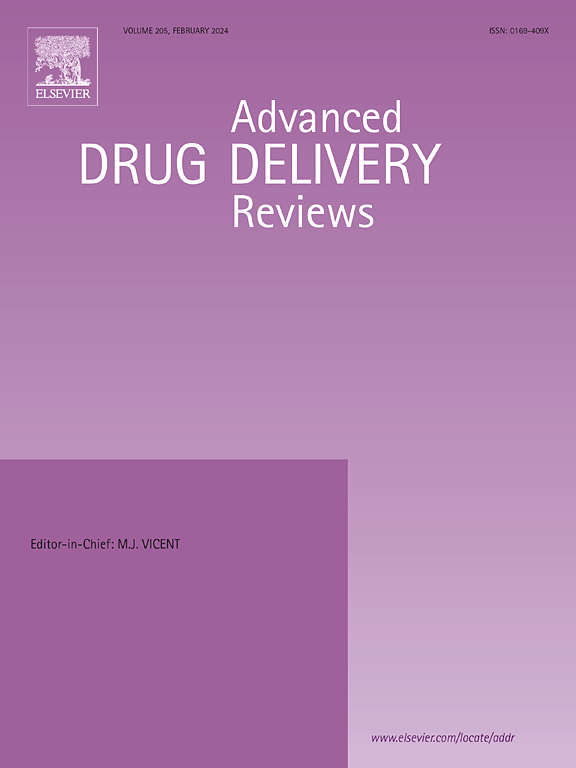From cell-SELEX to tissue-SELEX for targeted drug delivery and aptamer nanomedicine
IF 17.6
1区 医学
Q1 PHARMACOLOGY & PHARMACY
引用次数: 0
Abstract
Aptamers are nucleic acid-based ligands that can selectively bind to target molecules. Because of their unique target-binding properties, the use of aptamers for targeting cell surface molecules has attracted broad research interest. The field has evolved from selecting aptamers against purified surface proteins to using whole cells (cell-SELEX) as targets. To further advance the field, the concept of tissue-SELEX was later proposed to ensure that selected aptamers possess optimal binding properties in more native in vivo environments. In this article, we review recent progress made for tissue-SELEX, covering methods including tissue slide-based SELEX, morph-X-SELEX, ex vivo-SELEX, and microfluidic tissue-SELEX. The target tissues include cornea, breast, ovary, lung, cardiac and thyroid tissues. For the diseases targeted, cancer is the most extensively studied followed by cardiomyopathies and vascular conditions. The advantages of each method are discussed and potential limitations are also critically reviewed. Applications of tissue- or in vivo-SELEX-derived aptamers in drug delivery include local administration for ocular diseases and systemic administration for lung cancer. Finally, future directions are discussed, emphasizing the need for systematic comparative studies to evaluate cell-SELEX and tissue-SELEX derived aptamers, using antibodies as benchmarks to guide the development of clinically relevant therapeutic applications.


从细胞selex到组织- selex用于靶向药物递送和适体纳米药物
适配体是基于核酸的配体,可以选择性地与靶分子结合。由于其独特的靶向结合特性,利用适体靶向细胞表面分子引起了广泛的研究兴趣。该领域已经从选择针对纯化表面蛋白的适体发展到使用全细胞(cell-SELEX)作为靶标。为了进一步推进这一领域,后来提出了组织selex的概念,以确保所选择的适体在更原生的体内环境中具有最佳的结合特性。本文综述了组织-SELEX的最新进展,包括基于组织玻片的SELEX、morphx -SELEX、离体SELEX和微流控组织-SELEX。靶组织包括角膜、乳腺、卵巢、肺、心脏和甲状腺组织。对于目标疾病,癌症是研究最广泛的,其次是心肌病和血管疾病。讨论了每种方法的优点,并对潜在的局限性进行了严格的审查。组织或体内selex衍生适配体在药物递送中的应用包括眼部疾病的局部给药和肺癌的全身给药。最后,讨论了未来的发展方向,强调需要进行系统的比较研究来评估细胞selex和组织selex衍生的适体,以抗体为基准来指导临床相关治疗应用的发展。
本文章由计算机程序翻译,如有差异,请以英文原文为准。
求助全文
约1分钟内获得全文
求助全文
来源期刊
CiteScore
28.10
自引率
5.00%
发文量
294
审稿时长
15.1 weeks
期刊介绍:
The aim of the Journal is to provide a forum for the critical analysis of advanced drug and gene delivery systems and their applications in human and veterinary medicine. The Journal has a broad scope, covering the key issues for effective drug and gene delivery, from administration to site-specific delivery.
In general, the Journal publishes review articles in a Theme Issue format. Each Theme Issue provides a comprehensive and critical examination of current and emerging research on the design and development of advanced drug and gene delivery systems and their application to experimental and clinical therapeutics. The goal is to illustrate the pivotal role of a multidisciplinary approach to modern drug delivery, encompassing the application of sound biological and physicochemical principles to the engineering of drug delivery systems to meet the therapeutic need at hand. Importantly the Editorial Team of ADDR asks that the authors effectively window the extensive volume of literature, pick the important contributions and explain their importance, produce a forward looking identification of the challenges facing the field and produce a Conclusions section with expert recommendations to address the issues.

 求助内容:
求助内容: 应助结果提醒方式:
应助结果提醒方式:


